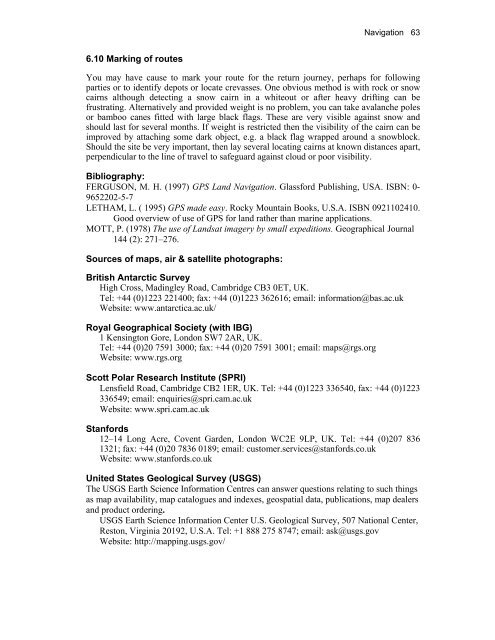Edited by Rachel Duncan 4th Edition ISBN 0-907649-91-2 London ...
Edited by Rachel Duncan 4th Edition ISBN 0-907649-91-2 London ...
Edited by Rachel Duncan 4th Edition ISBN 0-907649-91-2 London ...
You also want an ePaper? Increase the reach of your titles
YUMPU automatically turns print PDFs into web optimized ePapers that Google loves.
6.10 Marking of routes<br />
Navigation 63<br />
You may have cause to mark your route for the return journey, perhaps for following<br />
parties or to identify depots or locate crevasses. One obvious method is with rock or snow<br />
cairns although detecting a snow cairn in a whiteout or after heavy drifting can be<br />
frustrating. Alternatively and provided weight is no problem, you can take avalanche poles<br />
or bamboo canes fitted with large black flags. These are very visible against snow and<br />
should last for several months. If weight is restricted then the visibility of the cairn can be<br />
improved <strong>by</strong> attaching some dark object, e.g. a black flag wrapped around a snowblock.<br />
Should the site be very important, then lay several locating cairns at known distances apart,<br />
perpendicular to the line of travel to safeguard against cloud or poor visibility.<br />
Bibliography:<br />
FERGUSON, M. H. (1997) GPS Land Navigation. Glassford Publishing, USA. <strong>ISBN</strong>: 0-<br />
9652202-5-7<br />
LETHAM, L. ( 1995) GPS made easy. Rocky Mountain Books, U.S.A. <strong>ISBN</strong> 0921102410.<br />
Good overview of use of GPS for land rather than marine applications.<br />
MOTT, P. (1978) The use of Landsat imagery <strong>by</strong> small expeditions. Geographical Journal<br />
144 (2): 271–276.<br />
Sources of maps, air & satellite photographs:<br />
British Antarctic Survey<br />
High Cross, Madingley Road, Cambridge CB3 0ET, UK.<br />
Tel: +44 (0)1223 221400; fax: +44 (0)1223 362616; email: information@bas.ac.uk<br />
Website: www.antarctica.ac.uk/<br />
Royal Geographical Society (with IBG)<br />
1 Kensington Gore, <strong>London</strong> SW7 2AR, UK.<br />
Tel: +44 (0)20 75<strong>91</strong> 3000; fax: +44 (0)20 75<strong>91</strong> 3001; email: maps@rgs.org<br />
Website: www.rgs.org<br />
Scott Polar Research Institute (SPRI)<br />
Lensfield Road, Cambridge CB2 1ER, UK. Tel: +44 (0)1223 336540, fax: +44 (0)1223<br />
336549; email: enquiries@spri.cam.ac.uk<br />
Website: www.spri.cam.ac.uk<br />
Stanfords<br />
12–14 Long Acre, Covent Garden, <strong>London</strong> WC2E 9LP, UK. Tel: +44 (0)207 836<br />
1321; fax: +44 (0)20 7836 0189; email: customer.services@stanfords.co.uk<br />
Website: www.stanfords.co.uk<br />
United States Geological Survey (USGS)<br />
The USGS Earth Science Information Centres can answer questions relating to such things<br />
as map availability, map catalogues and indexes, geospatial data, publications, map dealers<br />
and product ordering.<br />
USGS Earth Science Information Center U.S. Geological Survey, 507 National Center,<br />
Reston, Virginia 20192, U.S.A. Tel: +1 888 275 8747; email: ask@usgs.gov<br />
Website: http://mapping.usgs.gov/

















